Related Research Articles

Giorgio Vasari was an Italian Renaissance painter and architect, who is best known for his work Lives of the Most Excellent Painters, Sculptors, and Architects, considered the ideological foundation of all art-historical writing, and still much cited in modern biographies of the many Italian Renaissance artists he covers, including Leonardo da Vinci and Michelangelo, although he is now regarded as including many factual errors, especially when covering artists from before he was born.

San Miniato al Monte is a basilica in Florence, central Italy, standing atop one of the highest points in the city. It has been described as one of the finest Romanesque structures in Tuscany and one of the most scenic churches in Italy. There is an adjoining Olivetan monastery, seen to the right of the basilica when ascending the stairs.
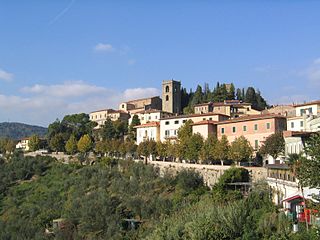
Montecatini Terme is an Italian comune (municipality) of c. 20,000 inhabitants in the province of Pistoia, in the Italian region of Tuscany. It is the most important center in Valdinievole. The town is located at the eastern end of Piana di Lucca and has a strong tourism industry, as well as industrial and commercial industries related to the spa, which in turn has increased the interest in hotel accommodation in the region.

Stradanus, Johannes Stradanus, Jan van der Straet or Giovanni Stradano was a Flemish artist active mainly in 16th-century Florence, Italy. He was a wide-ranging talent who worked as an easel and fresco painter, designer of tapestries, draughtsman, designer of prints and pottery decorator. His subject range was varied and included history subjects, mythological scenes, allegories, landscapes, genre scenes, portraits, architectural scenes and animals. After training in his native Flanders, he left his home country and ultimately settled down in Florence, Italy. He became a prominent court artist to the Medici during the second half of the 16th century and worked on the many decorative projects of the court. Stradanus also produced large altarpieces for the most important churches in Florence.
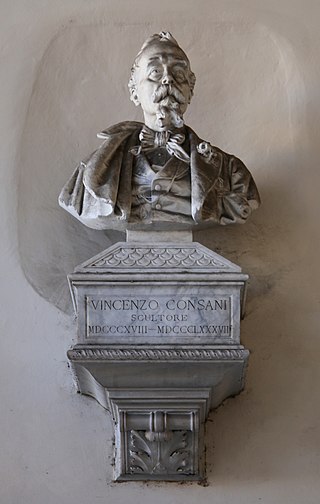
Vincenzo Consani (1818-1888) was an Italian sculptor from the Canova school. Consani's marble masterpiece statue Vittoria (1859) is in the Pitti Palace in Florence.

Fyodor Fyodorovich Kamensky was a Russian sculptor. From 1873 on he worked in the U.S.

Amos Cassiòli was an Italian painter, of battle scenes, historical canvases and portraits. He worked in a Purismo style.

Charles François Poerson was a French painter. He was director of the French Academy in Rome from 1704 until his death.

The Medici Fountain is a monumental fountain in the Jardin du Luxembourg in the 6th arrondissement in Paris. Built in about 1630, it was commissioned by Marie de' Medici, the widow of King Henry IV of France and regent of King Louis XIII of France. It was moved to its present location and extensively rebuilt in 1864-1866.
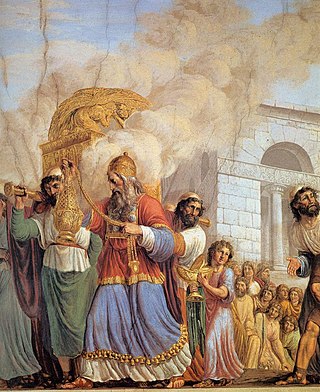
Luigi Ademollo was an Italian painter.

Camillo Torreggiani was an Italian sculptor.

Giulio Cesare Arrivabene was an Italian painter, active initially in a neoclassical style, mainly painting historic and religious canvases. He also was active as a portraitist.

Luigi Serra was an Italian painter, known for his watercolors.
Giuseppe Pierotti or Pier Giuseppe Pierotti was an Italian sculptor and painter. There is an Italian sculptor of the same name from Cuneo.

Allessandro Parronchi was an Italian poet, art historian, and literary critic. He won the 1999 Mondello Prize for literature.

Enrico Pazzi was an Italian sculptor, mainly active in Florence, Italy. He is known for his Monument to Dante (1857-1865) in the Piazza Santa Croce, Florence, and for the Prince Mihailo Monument in the center of Serbian capital city Belgrade.
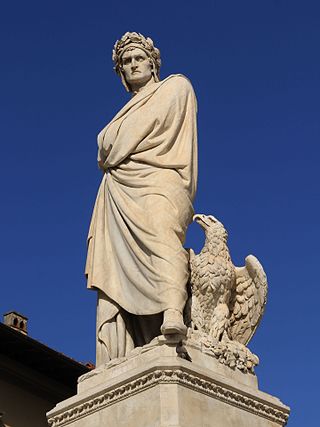
The Statue of Dante Alighieri is a monument to Dante Alighieri in Piazza Santa Croce, outside the Basilica of Santa Croce, in Florence, Italy. Erected in 1865, it is the work of the sculptor Enrico Pazzi.

The "workshop" of Pietro Bazzanti and Son is an historic landmark in Florence, art and culture heritage of the city. It took part in the role of "Fine Arts Trader" at the National Exposition of 1861 in Florence with several marble sculptures and various other works. The Bazzanti Marble Studio won the medal for the category "sculpture".
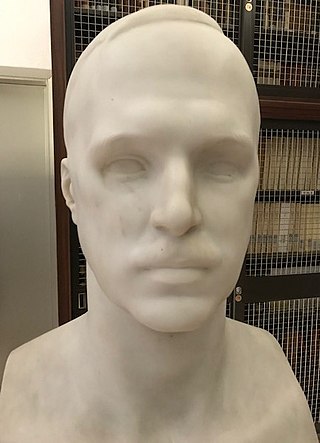
Guido Toja was an Italian actuary and president of the Istituto Italiano delle Assicurazioni.

Emilio Santarelli was an Italian sculptor active mainly in Florence.
References
- ↑ Luigi Bacarelli website, antique art dealer of Florence.
- ↑ Gli scultori italiani dal neoclassicismo al liberty, Vincenzo Vicario, Lodigraf (1990); page 336.